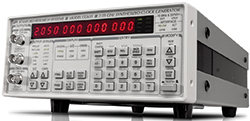
With exceptionally low phase noise and high frequency resolution, Stanford Research System’s CG635 clock generator provides a stable clock signal for developing and testing digital components, systems and networks. It can also replace RF signal generators in many applications.
The CG635 generates extremely stable square wave clocks between 1 µHz and 2.05 GHz — 16 digits of frequency resolution — with random jitter less than 1 ps RMS. The standard crystal time base has a stability of better than 5 ppm. Two options allow better frequency stability: an oven-controlled crystal oscillator (OCXO) will provide about 100´better stability and a rubidium source will provide 10,000× better stability. A 10 MHz time base input allows the instrument to be phase-locked to an external reference, and two CG635s can be locked using the 10 MHz output signal.
Clock phase resolution is 1 degree for frequencies above 200 MHz and increases by a factor of 10 for each decade below 200 MHz, to a maximum resolution of 1 nanodegree. This allows the clock edges to be positioned with a resolution of better than 14 ps at any frequency between 0.2 Hz and 2.05 GHz.
Two front panel BNC outputs provide complementary square waves at standard logic levels (ECL, PECL, LVDS or +7 dBm). The amplitude may be set between 0.2 and 1.0 V, with an offset from −2 to +5 V. These outputs have transition times of 80 ps and can drive 50 Ω loads. The levels double when the outputs are unterminated.
Stanford Research Systems
Sunnyvale, Calif.
www.thinksrs.com
